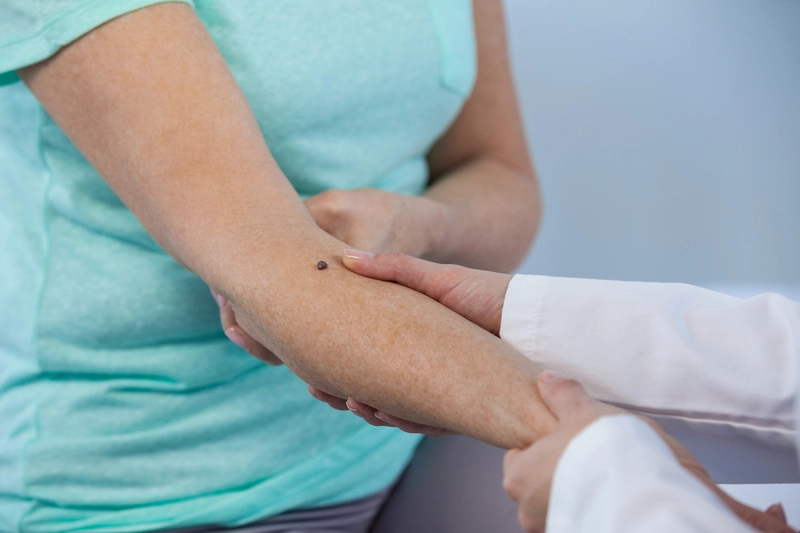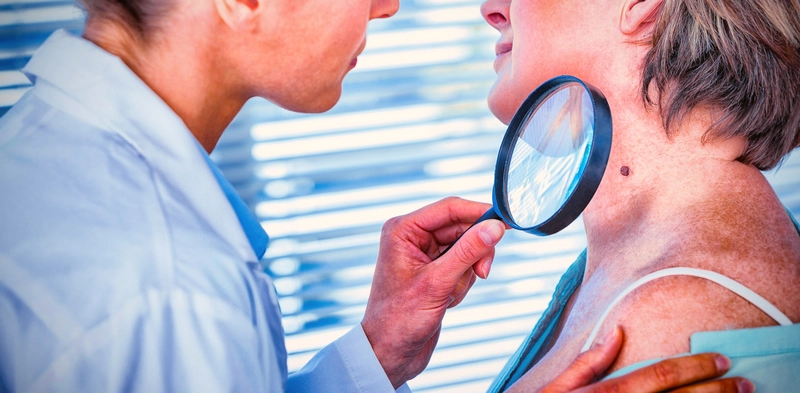Like most people, you may have at least one mole on your body. According to the American Academy of Dermatology (AAD), one in every 100 individuals has a congenital mole. An average person develops 10-20 acquired moles during their lifetime.
In most cases, these moles are not dangerous or harmful, and getting them removed is usually for cosmetic reasons. Whether or not you want those moles removed is entirely up to your preferences. However, some moles are cancerous and, therefore, must be removed.
Regardless of the reason, you want to go for the best mole removal solution from a qualified dermatologist instead of DIYing this procedure using a pair of scissors at home.
In this article, we will first discuss moles and their types. Then we will discuss the ins and outs of best mole removal and how to ensure proper care after you get rid of a mole.
Table of Contents
What are Moles?
As the US National Library of Medicine defines, a mole develops due to the formation of melanocyte clusters. Melanocytes are cells that produce melanin, which gives color to eyes, hair, and skin. Melanin also protects skin from UV rays.
Sometimes, melanocytes acquire specific mutations to form clusters, either due to UV light or any unknown reason. These clusters appear as flat spots or raised bumps, depending on the layer they lie in. Flat spots usually develop in the top layer, while raised bumps form in the dermis.
A person’s susceptibility to developing moles significantly depends on genetics. However, the tendency of a mole to turn cancerous is mainly due to sunlight or UV exposure.
What Are the Types of Moles?
Moles can be of different types.
- The first type includes benign moles, which are generally harmless. They can appear anywhere on the body and have a uniform color. They can be tan, brown, or pink and are relatively small. These moles remain unchanged over time and are not cancerous.
- The second type includes atypical moles, also known as dysplastic nevi. These moles are different from common moles in terms of color and shape. These moles are more likely to turn cancerous, even though such a development is still rare. However, it is crucial to keep an eye on dysplastic nevi if you have them on your body.
- The third and potentially most dangerous mole is a melanoma, also known as a cancerous mole. Melanoma is a skin cancer type that begins in melanocytes, forming a mole. People with white skin are generally more likely to develop melanoma compared to individuals with dark skin.
Why You May Have to Get Your Moles Removed
Most people across the world develop moles on their skins. Most moles are not harmful. So, your decision to remove such moles will be for cosmetic reasons entirely. Sometimes, a mole may become irritating when rubbing with your clothes. You may also want to get such a mole removed.
Some moles that necessitate you to undergo the best mole removal procedure are the ones that have changed with time. A change in the mole size, color, or shape can be a sign of skin cancer.
Removing Moles at Home
Many people discuss DIY methods to remove moles at home, something which dermatologists strongly disapprove of. Most DIY mole removal methods are not proven fruitful and may even end up harming your skin.
Here are some of those unproven mole removal methods:
- Using apple cider vinegar to burn off the mole
- Applying iodine, believing it will kill melanocytes
- Applying garlic to the mole
- Using a razor blade or a pair of scissors to cut the mole off (highly unrecommended)
Many best mole removal creams are available from drugstores and pharmacies. It is essential to scrape off the mole’s top part first to use these creams. Then, you have to apply those solutions to the mole. Manufacturers of such creams claim that using their products forms a scab in the mole’s location. This scab falls off along with the mole after some time.
If you are interested in DIY options, the best alternative is to conceal your moles instead of removing them. Using makeup to cover moles is a viable substitute.
Why is DIY Mole Removal Harmful?
Mole removal at home sounds convenient due to its supposed tendency to help you avoid a dermatologist’s office visit. However, no evidence suggests that a home treatment can actually work. The fact of the matter is it can be harmful.
According to a few studies, even the best mole removal creams can result in side effects. These side effects mainly include thick scars.
Using scissors or a blade to cut a mole at home carries a higher risk of infection, especially if the cutting tool is not optimally sanitized. Moreover, you might end up creating a permanent scar on the mole’s site.
Another pitfall of DIY mole removal is that you won’t know if a mole is cancerous. A cancerous mole is called melanoma, and removing it at home won’t stop cancer from spreading in the body and becoming life-threatening.
Read Also: Benefits of Shockwave Therapy
In-Office Best Mole Removal Options

Best Skin Mole Removal Surgeries
There are some of the best mole removal procedures you can go for, depending on the type of mole. A dermatologist will remove your mole during a single office visit. A second appointment is necessary only occasionally.
The two best mole removal surgical procedures are as follows:
- Shave excision – During this procedure, the dermatologist slices away the mole using a sharp razor-like tool. They may then use a device with an electrode to perform electrosurgical feathering.
- Surgical excision – This procedure is much like traditional surgery due to the depth of the treatment site. It may be the best mole removal treatment for dysplastic nevi. The dermatologist cuts out a circular skin patch containing the mole. The incision reaches the subcutaneous fat layer. After removing the mole, the dermatologist sutures the wound.
Laser Mole Removal
Laser is usually considered the best facial mole removal procedure due to reduced downtime. During this procedure, the dermatologist directs bursts of light radiation towards the cells making up the mole. This radiation destroys melanocyte clusters, removing the mole effectively. Laser treatment may be the best mole removal method, given that you are the right candidate for it. A dermatologist will tell whether or not laser treatment is the best mole removal procedure for you.
After the laser treatment, there will be a red spot on the mole site. You may have to cover this site with a temporary dressing. Soon after the treatment, a scab will develop on the treatment spot and remain in place for about a week. After the scab falls off, the mole site will be smooth and pale pink. This site will become just like the surrounding skin in a few months.
Scarring After Mole Removal
A surgical wound after mole removal surgery can leave a scar behind. That scar closes your skin and promotes healing of the wound.
In some cases, there can be large, raised scars due to abnormal scarring. The body starts making too much collagen, resulting in a hypertrophic scar.
Sometimes, an abnormal scar tissue growth can lead to a keloid scar, which is much larger than a hypertrophic scar. You may need corticosteroid injections or laser treatment to reduce keloid scars or stop scar tissues from overgrowing.
Post-Mole Removal Healing
The time required to heal after mole removal treatment depends on the individual’s age and overall health. Not to mention, larger incisions and wounds take longer to heal than smaller ones. On average, the healing process of a mole removal scar may take two to three weeks.
While you can start working on scar-reducing methods once the surgical site heals, ensuring initial wound care is crucial to prevent infections. Moreover, the initial wound care helps keep scar tissues from overgrowing.
Remember, paying attention to aftercare instructions from your doctor and nurse can help ensure the best procedure mole removal results. The size of the scar is a vital part of these results.
Different Ways to Reduce and Prevent Scars

Fortunately, there are a few proven steps to reduce and even prevent scars after mole removal treatment. While some of these steps are safe to try, you may need to discuss some with your dermatologist. You do not want to do anything that could worsen the scarring.
Avoid the sun
To ensure the best mole removal results, you have to prevent the wound’s direct exposure to the sun or UV rays. Such exposure can darken the surgical wound and cause permanent discoloration.
Make sure to cover your wound with more potent sunscreen when you are out. You can also use sun-protective clothing to cover that wound.
Avoid scratching the scar
We scratch some skin areas quite too often. This activity could lead to a lot of trouble if a mole removal scar happens to be in one of those areas. This scratching might prolong the healing duration and contribute to extensive scar formation even if your dermatologist used the best method of mole removal.
Keep the wound area clean and avoid dryness
Clean and appropriately moist wound areas tend to heal more quickly than dry wounds. You can use a moisturizing ointment, such as petroleum jelly, on the surgical wound and cover it with a bandage. Speak to your dermatologist about the new ointment once the scar tissue has developed. Ensure not to use an antibiotic ointment without your doctor’s instructions.
Massage the scar
Your sutures will be gone, and the scab will disappear two weeks after the mole removal procedure. You can start massaging the scar at that time. However, make sure not to pull the scab off because that can cause the scarring to worsen.
Do not start massaging the area until the scan disappears, even if it means waiting for more than two weeks. Use two fingers to massage the scar.
Polyurethane dressing
Polyurethane dressings are moist and flexible medical pads that promote quicker scar healing. Additionally, a polyurethane dressing can help prevent the formation of a raised scar. You may have to wear this dressing for six weeks after the mole removal procedure.
Consider laser and light therapies
You can get rid of many different types of scars with laser and pulse-dye treatments. These treatments reduce scar sizes, making them less noticeable. Generally, only one treatment session is sufficient to help you achieve the desired results.
Corticosteroid injections
You can speak to your doctor about corticosteroid injections. Corticosteroids are inflammation-reducing hormones that help treat many issues affecting joints, skin, and other areas and organs of the body. These injections can help reduce the appearance of raised scars, especially keloid scars.
Bottom line
Mole removal is a cosmetic procedure in most cases, but not when you notice a change in its shape, size, or color. Therefore, speak to your dermatologist about your scar to discuss the best mole removal methods. Also, ask them about the best mole removal aftercare and how to deal with the scar once the procedure wound heals.
Contribute By: Dubai Cosmetic Surgery



One thought on “Things You Should Know About Mole Removal”